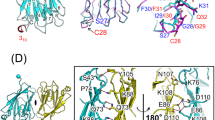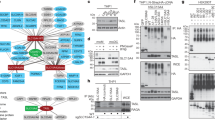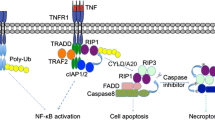Abstract
TNFAIP8-like 2 (TIPE2) has an essential role in immune homeostasis, yet the underlying mechanism remains enigmatic. The high-resolution crystal structure of TIPE2 reveals a previously uncharacterized fold that is different from the predicted fold of a death effector domain (DED). Strikingly, TIPE2 contains a large, hydrophobic central cavity that is poised for cofactor binding. These structural features will be important for understanding the functions of TIPE2 and other TNFAIP8 family proteins.


Similar content being viewed by others
Accession codes
References
Van Parijs, L. & Abbas, A.K. Science 280, 243–248 (1998).
Wahl, S.M., Wen, J. & Moutsopoulos, N. Immunol. Rev. 213, 213–227 (2006).
Nagata, S. & Suda, T. Immunol. Today 16, 39–43 (1995).
Sun, H. et al. Cell 133, 415–426 (2008).
Carmody, R.J., Hilliard, B., Maguschak, K., Chodosh, L.A. & Chen, Y.H. J. Neuroimmunol. 133, 95–107 (2002).
Kumar, D., Whiteside, T.L. & Kasid, U. J. Biol. Chem. 275, 2973–2978 (2000).
Kumar, D. et al. Oncogene 23, 612–616 (2004).
Patel, S., Wang, F.H., Whiteside, T.L. & Kasid, U. Oral Oncol. 33, 197–203 (1997).
Yoshinaga-Hirabayashi, T. & Yoneda, Y. Ital. J. Anat. Embryol. 106, 51–57 (2001).
Zhang, C. et al. Mol. Ther. 13, 947–955 (2006).
Fesik, S.W. Cell 103, 273–282 (2000).
Holm, L. & Sander, C. J. Mol. Biol. 233, 123–138 (1993).
Lin, L.Y., Ching, C.L., Chin, K.H., Chou, S.H. & Chan, N.L. Proteins 65, 783–786 (2006).
Park, H.H. et al. Annu. Rev. Immunol. 25, 561–586 (2007).
Acknowledgements
We thank N. Shimizu at the Spring-8 beamline BL41XU and T. Kumasaka and S. Baba at beamline BL38XU for help. This work was supported by funds from Tsinghua University (Y.S.).
Author information
Authors and Affiliations
Contributions
X.Z. carried out biochemistry experiments, crystallization and data analysis and prepared the manuscript; J.W. carried out structure determination; C.F. and H.L. assisted X.Z.; H.S., S.G. and Y.H.C. were involved in collaboration and discussion; and Y.S. supervised the research and prepared the manuscript.
Corresponding author
Supplementary information
Supplementary Text and Figures
Supplementary Figures 1–3, Supplementary Table 1 and Supplementary Methods (PDF 446 kb)
Rights and permissions
About this article
Cite this article
Zhang, X., Wang, J., Fan, C. et al. Crystal structure of TIPE2 provides insights into immune homeostasis. Nat Struct Mol Biol 16, 89–90 (2009). https://doi.org/10.1038/nsmb.1522
Received:
Accepted:
Published:
Issue Date:
DOI: https://doi.org/10.1038/nsmb.1522
- Springer Nature America, Inc.
This article is cited by
-
The TIPE Molecular Pilot That Directs Lymphocyte Migration in Health and Inflammation
Scientific Reports (2020)
-
Tumor necrosis factor-α-induced protein 8-like 2 mRNA in peripheral blood mononuclear cells is associated with the disease progression of chronic hepatitis B virus infection
Virology Journal (2019)
-
TIPE2 acts as a biomarker for tumor aggressiveness and suppresses cell invasiveness in papillary thyroid cancer (PTC)
Cell & Bioscience (2018)
-
TIPE2 acts as a biomarker for GIST risk category and suppresses the viability and invasiveness of GIST cells
Cell & Bioscience (2018)
-
Structural basis of Gip1 for cytosolic sequestration of G protein in wide-range chemotaxis
Nature Communications (2018)





